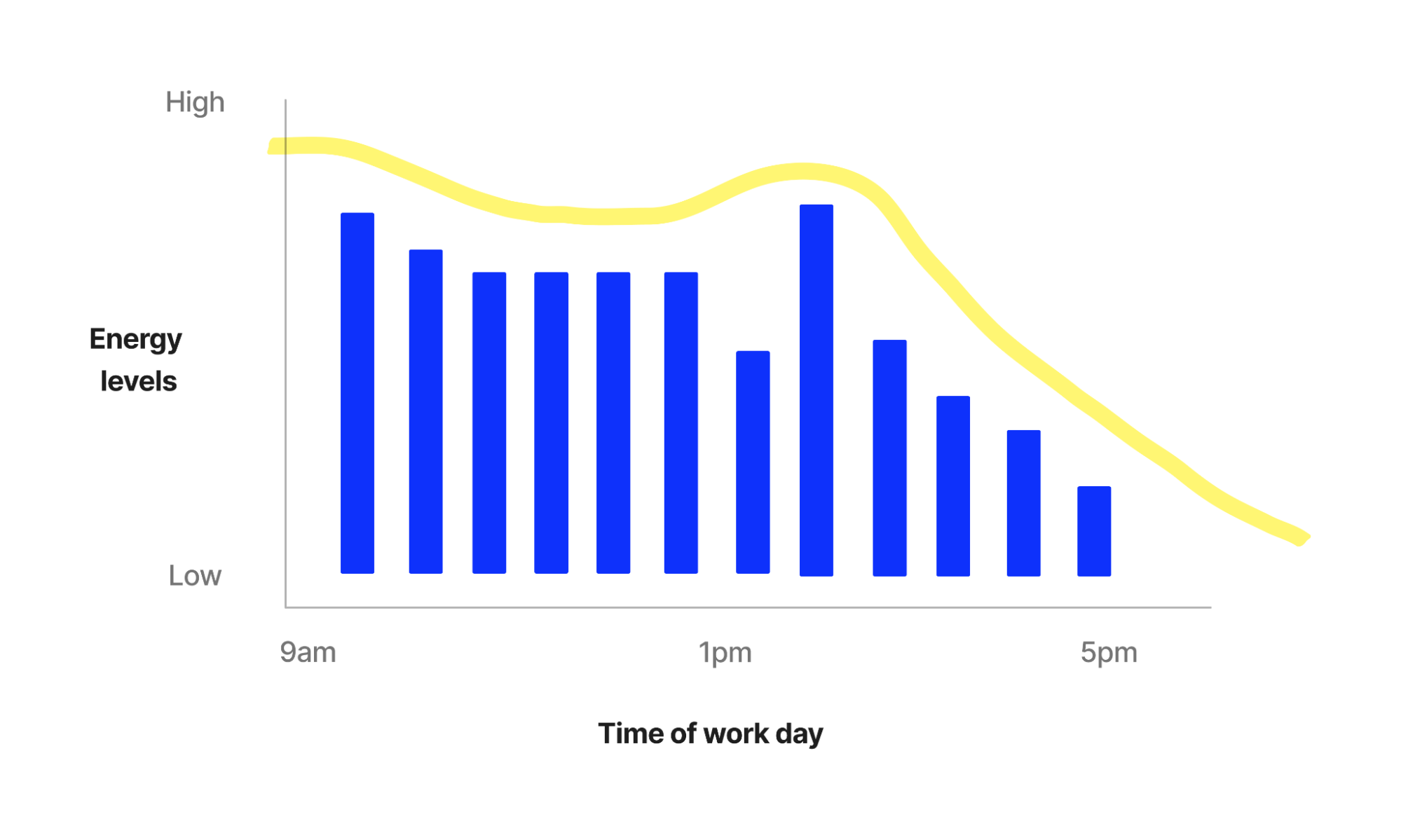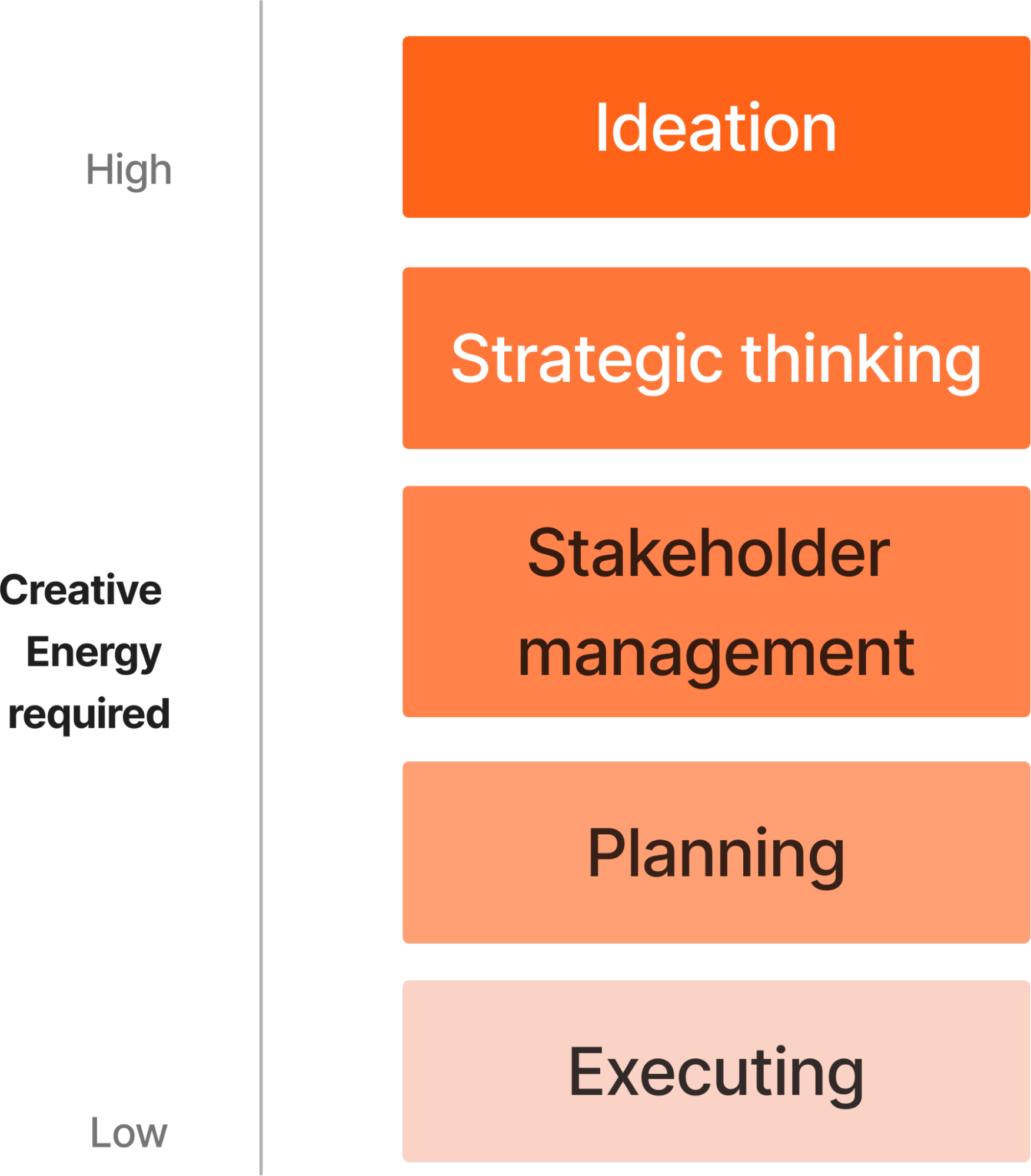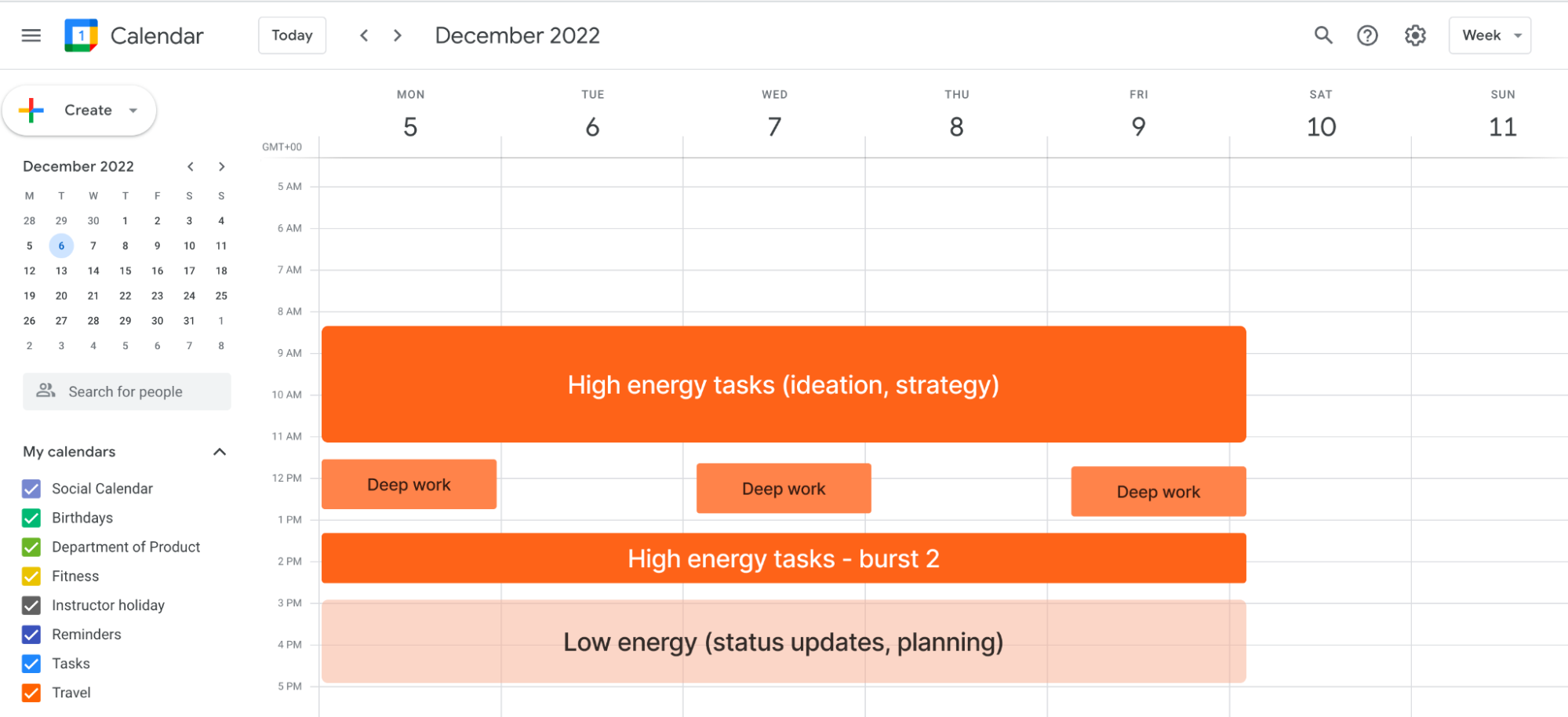How to Structure your Day Using Energy Levels as a Product Manager
Product team members who don’t work in product management roles sometimes wonder what on earth product managers do all day. Some days, all they see is a 10 minute snippet during a daily stand up where a product manager may, or may not, provide a short update which rarely involves actually building anything.
Queue the chatter about “what do they do all day, anyway”?
Sure, a lazy PM could probably get away with doing very little if they tried hard enough to avoid work as much as possible. But product people don’t go into product to avoid work: we’re often passionate about building products, generating new ideas and thinking strategically about how we might win. That’s why we do it in the first place. It’s a stimulating role which rarely gets boring.
But, with product management often requiring a diverse bunch of different skill sets, it can be overwhelming to try to structure your day in a way that optimises each of the activities these skill sets are used for.
What’s the best way to manage the tasks a PM might typically be required to do in a day? Glad you asked, let’s find out.
First, let’s consider the activities a product manager might do:
- Planning
- Ideation
- Strategic thinking
- Stakeholder management
- Executing – getting sh*t done
Each of these requires different levels of energy. Some are energy intensive, others are more procedural in nature, which don’t require as much cognitive energy. This is mostly based on my own experience, of course, rather than being steeped in scientific research, so take anything I say with a large pinch of amateur scientist salt.
A working week
We all have the same 5 days to work with . And sure, we can’t control when every single activity should take place; often things spring up out of the blue and you have no control over them.
But let’s assume you do have some degree of agency over your diary. Given the typical tasks a product manager might face, what would be the optimal way to set up your week based on energy levels?
Energy levels throughout the day
A person’s energy levels are driven by a bunch of different factors but all humans have a circadian rhythm that is linked to the sun and our body’s internal clock.
I’m not going to get into circadian rhythms too deeply here, mostly because I’m not a doctor and don’t know much about them, but what I will say is that it seems broadly agreed that a critical part of a healthy circadian rhythm is exposure to sunlight early in a day. This is an interesting article on the topic of sunlight, sleep and productivity.
Sunlight exposure kick starts the body’s production of melatonin which helps your body to regulate sleep. So whilst many of us are still working from home without a morning commute, a great way to kickstart your productivity could be to simply walk outside for 10 minutes.
But that’s enough of the science of body clocks. Let’s assume you’re getting a decent night’s sleep and you’re exposing yourself to a healthy dose of sunlight (even if you live in a cloudier climate).
Aside from sleep and sunlight, other factors will impact your energy levels including:
- Caffeine
- Sugar
- Stress hormones
So your energy levels throughout the day could look something like this:

Which of the core product management activities make sense to do at different energy level points throughout the day?
First, let’s have a crack at ranking activities based on the brain power required. Again, this is purely based on my own personal feelings and not much else.
If I were to rank the activities based upon the brain power required, I’d argue the ranking would look a bit like this:

Ideation
Some have argued that product management is more to do with idea curation, rather than idea generation. Whilst there’s plenty of truth to this, product management is no fun without the creative aspects of idea generation.
Idea generation tools and techniques for product management include:
- Idea sandwiches – take two or more unrelated concepts and mash them together in new, interesting and absurd ways.
- Feature theft – laterally apply features from one product (not necessarily – and ideally not) a competitor and apply them to your own product
- Forced idea generation – forcing yourself every day to come with ideas – not necessarily linked to your own product; just creative ideas for new businesses or solutions.
- Eat idea generating foods – foods can impact your ability to generate ideas. Here’sa list of brain optimising foods and habits can help you become more creative
The best times for ideation
Since ideation is so energy intensive, I would aim to generate ideas earlier in the morning after you’ve had a glass of water or cup of coffee.
That said, good ideas can often bubble to the surface when you’re doing something completely unrelated to the idea generation topic in hand. Allow yourself some down time where your mind can wander (shower time or during exercise) and you’ll be surprised by the ideas you’re able to generate. The key though, is to be clear in your mind about what topic you’re focused on; give yourself a topic to focus on and ask your brain to help you generate ideas.
Strategic thinking
We’ve ranked strategic thinking as the second most energy-intensive activity a product manager might be involved in.
Strategy requires you to step away from the finer details of product management and to zoom out to a macro level to understand your product and where it sits in the wider competitive landscape of your business.
This isn’t as acutely intensive as attempting to generate new ideas on the spot, but strategy does clearly involve creativity, too.
The best times for strategic thinking
Again, there is definitely plenty to be said for just allowing your mind to wander in a focused way. But broadly speaking, I’ve often found strategic activities to be best placed in the morning when you’re feeling full of beans and ready to engage with the day ahead.
Who wants to think about differentiation tactics at 4pm on a Friday? No thanks.
Stakeholder management
Stakeholder management can be intensive.
Negotiation skills, for example, are essential for successful stakeholder management – and negotiating is exhausting.
But whilst managing stakeholders might be exhausting and creative in its own way (ideating solutions to problems and navigating complex interests), I’d argue it isn’t as energy-intensive as creating brand new ideas from scratch.
Stakeholder management activities don’t just mean tough negotiations. It can often involve softer activities that aren’t as energy resource intensive such as:
- Keeping folks up to date with progress
- Sending comms with new roadmap items and explaining the rationale behind them
- Communicating the performance of a new release
These are all part of the role of product management, but are definitely less taxing than other activities – especially if you make use of no-code tools to do the heavy lifting for you.
When should you do stakeholder management?
I’d argue that stakeholder management activities are best suited to the afternoon. Given that they’re less taxing on the brain, firing off a few status updates in the afternoon is a task you can get done with a belly full of lunch pretty easily.
That said, if we’re talking about a difficult conversation that is likely to result in some conflict that needs resolving, earlier in the day when you’re feeling more energised might work.
Using the power of the days of the week to your advantage
One tip for resolution conflict I’ve used in the past: if you have stakeholders who rarely agree on anything and you need their buy-in on something, schedule a meeting on a Friday.
Fridays are feel-good days where, in my anecdotal experience at least, people seem far more open and agreeable than on other days. If you have stakeholders who you’re really struggling to work effectively with, try scheduling in some time on a Friday to resolve the conflict. It sounds pretty absurd, but I’ve found that the feel good effect of a Friday can rub off onto your relationship, too.
Activities and days of the week – which day works best?
Here’s some sweeping generalisations about the days of the week – and what this means for your approach to product management:
- Mondays – lots of people are miserable after the weekend so use this as an opportunity to communicate BAU or planning activities
- Tuesdays – widely thought of as one of the most productive days of the week. Open rates on email campaigns are highest on Tuesdays since people have banished the memory of the weekend and are in full on work mode. Use this day for idea generation, strategy workshops and other energy-intensive tasks.
- Wednesdays – the momentum is still with you so continue to get through energy intensive tasks.
- Thursdays – one eye is on the weekend. The week is starting to take its toll. Lay off on the energy intensive tasks and instead consider focusing on planning and comms activities.
- Fridays – use the feel good Friday to your advantage. Build relationships with stakeholders and end the week with product demos to show off what your team’s been up to.
Planning
Planning doesn’t typically involve too much creativity. It’s usually deciding what to do with decisions that have already been made elsewhere at another time.
Yes, you might have to consider tricky concepts like scope management, but planning isn’t too taxing in comparison to other product activities.
If your diary allows it, try scheduling your planning sessions in the afternoon rather than the morning, and keep your morning time reserved for more strenuous tasks.
Executing
Executing means getting stuff done. And since product managers aren’t the ones actually ‘doing’ the engineering or design work, execution might seem rather puzzling for those who don’t work in product.
What does executing mean as a PM?
- Answering 5 different questions from 5 different people on Slack threads
- Commenting on a design prototype
- Prepping for an upcoming user research session
- Providing feedback on an interview candidate
- Writing user stories or PRDs
These are all examples of executing as a PM and there isn’t always a simple way to batch these tasks asynchronously.
‘Deep work’ is a concept where you block out time in your diary to focus on a single task or set of tasks. In a distraction free 45 minut session you’ll be amazed at how much execution you can get done. Tools like Freedom help you stay on track by blocking distracting apps including social media websites across both your desktop and mobile accounts.
Some of the most productive bursts of getting stuff done for me has involved using Freedom to set 45 minutes aside with no distractions.
Bringing it all together
So what could an energy-optimised day as a product manager look like?
Well, using my crude tactics for categorising product management activities, it could look something like this:

Caffeine-packed mornings are reserved for ideation, strategy workshops and tough negotiations. Afternoons are reserved for the rest. Executing happens throughout the day in deep work bursts.
Sure, you can’t force your colleagues to operate using the same energy level patterns as you, but understanding your own energy levels and tailoring your working patterns as much as possible to work is a great place to start.



